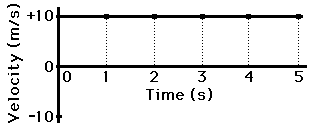Leaderboard
Popular Content
Showing content with the highest reputation on 05/23/20 in all areas
-
This is awesome. A picture of the dust cloud around a star 520 light years away. But better than that, there are signs that a planet is forming. Full story here: https://www.eso.org/public/news/eso2008/ Note that this is a real image, not a simulation or "artists impression"1 point
-
Hello. Not sure I understand your question but here is an attempt, also using geometry. I'll try to include your note regarding the sum v+v+v... If you have a constant velocity v and plot a graph you could think of the distance s as the area under graph. A numerical example: So to calculate the distance we could use multiplication 5*10=50 in this case (5 seconds of 10m/s velocity) or we could just use sum 10+10+10+10+10=50. Numerical result is the same. But I think the physical result is different. Le's take a to take a look at the units. Velocity is m/s and time is in seconds. If we just add velocities 10+10+... We have, physically, an increase in speed from 10 m/s to 50 m/s. So for the sum to physically get the correct result, the distance, we need to include the multiplications: 10*1 + 10*1 +...=50. Or with units spelled out: 10 m/s *1s + 10 m/s *1s +...=50m. Side note: When stating v+v+v+v... maybe you are looking for https://en.wikipedia.org/wiki/Integral ?1 point
-
I'm not taking you seriously 100 %. But I'm interested in your definitions. 1) Your notation is confusing at best. I would first drop the h bar. I don't know what quantum mechanics is doing there. Also, no need for the partial derivative symbol. \[P=-i\frac{d}{dx}\] Your left and right shift operators I have re-named L and R: \[f_{R}\left(x\right)=Rf=f\left(x\right)-f\left(x+1\right)\] \[f_{L}\left(x\right)=Lf=f\left(x\right)-f\left(x-1\right)\] So that, \[G=L\left(XP+PX\right)R\] I'm not sure your operator is compact or admits a compact extension. 2) It seems like you're extending Riemann's zeta function to include a real variable x taking values on the real line. Taking x=1 doesn't take you back to Riemann's zeta function. You should be more explicit about what you're doing there. 3) Your definition of scalar product involves only integration/sum from 1 to positive infinity. That would require some heavy-duty extensions and checks of your definitions (closeness, domains, etc.) 4) X and P are unbounded operators that do not belong to the trace class operators. IOW: Look out for mistakes, especially if you're using anything like traces. Example of simple arguments that miserably fail with them: \[\textrm{tr}\left(XP-PX\right)=0\] \[\textrm{tr}(-iI)=-i\times\infty\] 5) Soundness of passing an operator from left to right in a scalar product depends on subtle questions about domains, not only on real character of its "formal" spectrum. You must check that you're not letting out the accumulation points of your domain in case it's not compact (topological argument.) 6) Related to the previous: Your "left operator" takes you out of the domain of your scalar product. Doesn't that have any bearing on your "proof" of something? I'm just curious. That's all.1 point
-
I'm not entirely sure if this is relevant but we get quite a lot of "multiple truths" in law enforcement such as independent witnesses giving conflicting accounts of the same event, potentially false memories of childhood trauma, or the weapon-focus effect. All these are influenced, in varying degrees, by an observers' unconscious bias, their (flawed?) perception or outside influences. The knack it to test the observations and piece together the most likely "truth" then let a jury decide. A bit like peer review, I suppose.1 point
-
'There 's not one atom of yon earth But once was living man; Nor the minutest drop of rain, That hangeth in its thinnest cloud, But flowed in human veins; And from the burning plains Where Libyan monsters yell, From the most gloomy glens Of Greenland's sunless clime, To where the golden fields Of fertile England spread Their harvest to the day, Thou canst not find one spot Whereon no city stood. 'How strange is human pride! I tell thee that those living things, To whom the fragile blade of grass That springeth in the morn And perisheth ere noon, Is an unbounded world; I tell thee that those viewless beings, Whose mansion is the smallest particle Of the impassive atmosphere, Think, feel and live like man; That their affections and antipathies, Like his, produce the laws Ruling their moral state; And the minutest throb That through their frame diffuses The slightest, faintest motion, Is fixed and indispensable As the majestic laws That rule yon rolling orbs.' Another one from PBS...1 point
-
Or: "There is something I don't understand about ..." This has caused problems in the past where someone has started out with something like "I have a doubt about evolution/relativity/whatever" and get an initially hostile response because it sounds as if they are disputing the topic. But all they really mean is they lack knowledge/understanding and have a question.1 point
-
As someone said, "do you remember your previous consciousnesses (or those that exist elsewhere in an infinite universe) ?" No. So, obviously future ones will not remember you. So it will not be the same "I" even if it happened.1 point
-
Yes, but you need to look at it in geometric terms. You start out at some point P, and make that the origin of your coordinate system. Velocity is a vector, so you draw that onto your chart, which gives you an arrow that points from your origin to some new point P’: P’=0+v. The factor t is a scalar, so what the multiplication v*t means is that it lengthens the vector v, keeping its origin and direction unchanged: |s|=(0+v)*t=v*t That is the meaning of this kind of multiplication - it lengthens a vector along the direction it points in. The resulting quantity s is then just the total length of that new vector, which physically speaking is the point you get to after travelling for a time t with velocity v, being the tip of the new arrow in your drawing.1 point
-
I am honestly not sure if I follow your thought process correctly, since such a notion as “time dilation gradient” does not make much sense to me. But nonetheless, the aforementioned case of an orbit around a rotating mass should be an example. Another scenario that immediately comes to mind would be two parallel beams of light (or any other pp-wave spacetime, for that matter) - if you fire two parallel beams of light in the same direction, there will be no gravitational attraction between them, even though they carry energy. But if you fire the same two beams of light so that they are initially parallel, but travel in opposite directions (i.e. you let emitter and receiver trade places for one of the beams), then they will indeed experience a gravitational attraction. There will of course be time dilation between a clock inside the volume of dust, and some other reference clock outside of the dust cloud; but there is no time dilation between two clocks that are both located inside the dust cloud. I should have been more clear on this, as I was initially thinking of the cosmological case, where there is no “outside”. As I said, I don’t immediately recall where I saw that proof, it was a few years back when I came across it, and it was in a printed textbook. However, I can offer an outline (!) of my own attempt at proving this, for whatever it is worth. For this, allow me to go back to the basics, and consider what it actually means for a manifold (such as spacetime) to have curvature, and how to capture this mathematically. Imagine you choose some arbitrary point P on your manifold, and pick out an arbitrary tangent vector attached to that point. Now you parallel-transport that tangent vector around a small (i.e. infinitesimal) loop that starts and ends at your point P. The question is - will the initial vector before the parallel transport operation coincide with the final vector at the end of the procedure, regardless of the specific curve the loop describes, and what direction I travel on that loop? On a flat manifold, using standard calculus, the answer is obviously yes (I use single bars “|” to denote ordinary derivatives), since ordinary derivatives commute: \[A_{\mu |\nu \gamma } -A_{\mu |\gamma \nu } =0\] However, if we allow the manifold to not be flat, then the situation changes; following the standard prescription for this (refer to any textbook on differential geometry), we must now replace ordinary with covariant derivatives, which do not in general commute. The degree to which they fail to commute is (I use double bars “||” to denote covariant derivatives): \[A_{\mu ||\nu \gamma } -A_{\mu ||\gamma \nu } =R{^{\delta }}{_{\mu \nu \gamma }} A_{\delta }\] The object \(R_{\mu \nu \gamma \delta}\) is called the Riemann curvature tensor, and it uniquely specifies all aspects of the geometry of a given manifold. The question then becomes how you explicitly calculate the components of the Riemann tensor, i.e. what kind of object is it a function of? For this you need to only remember that GR uses the Levi-Civita connection, which is torsion free; this implies symmetry in the lower indices of the Christoffel symbols: \[\Gamma {^{\gamma }}{_{\mu \nu }} -\Gamma {^{\gamma }}{_{\nu \mu }} =0\] This being the case, you can then work out an explicit coordinate expression for the Riemann tensor from the above equations. I won’t typeset it here now since it is tedious to write in LaTeX notation (you can easily Google it, if you are interested) - I will simply point out that the Riemann tensor turns out to be a function of the connection coefficients and their derivatives only, which in turn are functions of the metric tensor and its derivatives only. So in other words, and that is the point of this whole exercise, given the fact that GR uses the Levi-Civita connection to describe parallel transport, a unique description of all relevant aspects of a manifold’s geometry under GR (i.e. the Riemann curvature tensor) arises from a rank-2 tensor, being the metric tensor. A simple accounting of the indices in the above expressions show that there is no mathematical possibility of any lower rank object (such as a scalar or vector) doing the same job. Which is what we wanted to show. The above is obviously only an outline - you could fill in the details and actual calculations yourself, using any standard textbook on differential geometry. I don’t know how rigorous the above really is, but that’s how I would approach such a proof - quantify the failure of derivatives to commute on curved manifolds; then, given a connection, check what kind of object the coordinate expression for the curvature tensor depends on. It seems pretty simple and logical to me. But if someone here who is actually an expert in the area can think of a better, more rigorous way, or can point out an error in the above reasoning, then I would definitely be interested in seeing it!1 point
-
No single book will be the 'most advanced' in any technical subject these days. Also since you are going to University or Polytechnique you will be taught things on your course that are not in any book. I remember one Professor coming in and saying "You will not find this reaction in any book - I only discovered it last week.) About the Housecroft book It is already far more than you will probably ever need 1285 pages in the 2018 edition. As you say you are studying Chem Eng, not Chemistry. My flatmate at Loughborogh studied Chem Eng and didn't have any heavy Chemistry books. Is it the recommended course book? In which case there will probably be exercises from it that you will need. Robert Gordon University Pharmacy publishes a list of recommended books and articles and notes whether ther are just for looking at, extra reading or 'essential'. Find out if your institution does this and play close attention to it> Do not miss any reference they call essential - it may come up in the exam. There will be plenty of stuff (and higher mathematics) in Chemical Engineering that Chemists do not study. Put your best efforts into that would be my advice.1 point
-
Besides the people who died merely by following his shit advice directly (drink Clorox?), there’s also the issue of all the weeks he spent downplaying things and trying to spin information so he wouldn’t look bad... every second he was unclear and was prevaricating could’ve instead been used manufacturing tests and PPE and generating support for a collective “we’re all in this together, let’s wear masks” response. Even today, wearing masks has become political, he forces his people to take them off in meetings, and he’s contradicting the advise of his own experts. Tens of thousand of deaths could’ve been avoided, but he was too busy blaming Obama like a fucking toddler1 point
-
That I can answer. These levels of crises generally require somewhat centralized responses. States are not able to track or control international travel, for example. Now we have documented it before, but the big issue with the WH response is not only that they were too late in their response (which to various levels was also the case in other countries). But the problem is that even once the issue was recognized, the WH continued to downplay the risks and contradicting their own experts, which effectively puts folks at risk. And obviously there are federal responses to, say PPE seizure and redistribution that appear to be confusing at best. They might be redistributing them to where they are needed, for example, though the WH says that everyone has enough (thus indicating seizures and redistribution are not needed) whereas local leaders indicate that they are in a bidding war to actually get supplies. So not only being inactive, the actual actions are problematic or at least unexplained. None of which is good in a crisis. In other words, if you are given the power to actually coordinate efforts around the country but cannot make up your mind even within a single interview whether a crisis actually exists, I think it is fair to state that one is not fulfilling ones responsibility. Now going back to the impact, other countries that were hit harder, also had the issue of belated responses. Effectively for most of the Western world Italy was the start signal, rather than China. But the difference is that after that most governments (local and federal) kind of agreed on a strategy, and started implementing them. Meanwhile, the US had a strategy and then they basically said that they are not necessary (including their own guidance, or shelving guidance from the CDC). Yes the US has lower population density overall resulting in less spread in certain areas, similar to, say Canada there are hotspots. But even so death rates are close to much more densely populated areas. But perhaps worse than that, the other countries that have been hit harder, are flattening the curve. New cases are dropping across the board (except perhaps the UK), with levels around 12-15% compared to peak times. The US, is still at around 70%. And it is hard to believe that the political climate in the US is not at at fault for that. The US has some of the finest institutions in the world to deal with these issues- and normally states would be expected to fall in line when the Feds are creating strong responses. Now we have got folks thinking that it is a hoax.1 point
-
Considering the ruckus that was made over the death of 3000 people on 9/11, and the trouble three successive governments went to, to mitigate and punish the perpetrators of the incident, I find the government's nonchalant attitude regarding the death of >90 000 people slightly unsettling. Re-election is more important than lives. That's 92 000 people, so far ... Other world leaders are not much better. And I ( and many other countries ) aren't letting China off the hook either. If China didn't want to politicise the Dovid-19 response, thy should have at least allowed Taiwan's observer status at the WHO, and the WHO should have heeded Taiwan's warnings in December instead of being China's mouthpiece and claiming there was no human-to-human transmission for three weeks. Saving face is more important than lives. But as bad as all the others are, none of them, not even B Johnson, has ever suggested people inject bleach disinfectant, or shine a UV llight up their butt.1 point
-
President Trump's strategy is simple ... He ran on a platform of 'draining the swamp'. He's fired four IGs in quick succession; the latest for investigating Pompeo's misuse of resources. I guess without IG overseers ( or free press ), he can claim there is no swamp. Similarly, since infections were found in White House staff, everyone there is tested daily; The rest of the country is way undertested. I guess without testing, he can also claim there is no more virus. What bothers me is his supporters, who defend him and buy into his crap. Abuse and overreach of power, nepotism, pay to play, bribery, corruption, and the worst response to the pandemic of any civilized country, and he still has that kind of support ( people thinking he's doing a god job ) ?1 point
-
! Moderator Note The problem is not from those reading. The problem is that you can't explain what makes so much sense in your head. This is mostly because a) you made up your own definitions for lots of mainstream terms, b) you've allowed a great deal of guesswork to fill the gaps in your knowledge, and c) you keep leaping to conclusions before making sure your last steps were sound. Please, try to understand why people are posting the things they are. NOBODY IS SKIMMING. They're stumbling on science snags, picking out the flaws, hopefully the very thing that made you post your idea here. They're finding misunderstanding and misinformation and vagueness in areas where clarity and trustworthy methodology are paramount, and they're trying to let you know about it. But you claim they aren't reading, which means you really aren't listening. Eight pages of this! Imagine if someone came to you with an idea for (picking something at random) cleaning residential carpets, and right away they start talking about taking them to a facility. You start shaking your head. You know that won't work because most people have wall-to-wall, it would cost a fortune to remove it for cleaning and then replace it. They accuse you of not hearing them out, of skimming over their idea, as they continue to tell you about how many people work at their facility, and show you pictures of tropical fish, and insist they don't need any of the special tools other carpet cleaners rely on. Is the problem with you, or with them? We see a great deal of this. When someone keeps preaching an idea without listening and incorporating input from others (IOW, discussion), it's called Soapboxing. Very frustrating in a discussion, so we made it against the rules. It works better for a blog, though, so I'm going to suggest you start one somewhere. THIS is a science discussion forum. Thread closed.1 point
-
1 point
-
The matrix A in question has an eigenvalue of zero and hence is not invertible. Since [math] Av_0 = 0 [/math] (as given in the text) you immediately get [math] AAv_0 = A0 = 0 [/math] for [math]v_0 \neq 0 [/math].1 point
-
I believe that in accordance with the third law of Hegel's dialectics ( development goes in a spiral), physics will somehow return to the ether as a medium for the propagation of interactions. Of course, not to the Lorentz model, but on a new level. Most likely, the term "ether" itself will be replaced with another one.However, this is already happening, because the vacuum in the modern sense is not a void.-1 points
-
Is time absolute or relative According to general relativity, time is relative meaning people moving at different rates at different positions will experience different times which can be denoted by their time piece (watch). Here is my thought experiment: Imagine people playing soccer on a field, due to each players rate of motion and position, each will experience different times. Now I decide to videotape the game on my camcorder and later watch it on my television. On the home video each player’s time may still be relative to each other but to me as the observer they are all experiencing the same time according to my clock on the wall. This is the universal time or absolute time. We all exist in the universal time frames similar to the time frames on my home video. Everybody in this universe experience relative time on the universal time frames but to the observer outside the time frames (GOD), there is a universal time also known as absolute time. Time is absolute; time is relative which matches the yin yang concept of the existing duality.-1 points













